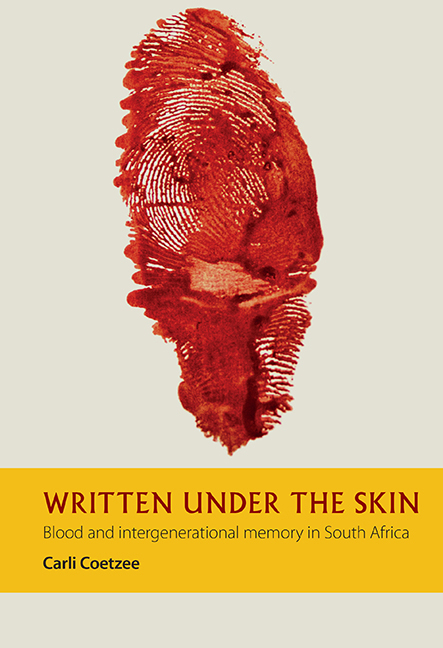Book contents
- Frontmatter
- Dedication
- Contents
- Preface
- Introduction: Piercing the Skin of the Present
- Part I
- 1 Reading Mandela's Blood: The Transition, and the Cell as Portal into Bloodless Time
- 2 He Must Not Circulate: Eugene de Kock's Blood Relations and his Prison Visitors
- 3 Ruth First's Red Suitcase: In and Out of the Strongroom of Memory
- 4 A Life Transplanted and Deleted: Hamilton Naki and his Archivists
- Part II
- Bibliography
- Index
- Miscellaneous Endmatter
3 - Ruth First's Red Suitcase: In and Out of the Strongroom of Memory
from Part I
Published online by Cambridge University Press: 26 March 2019
- Frontmatter
- Dedication
- Contents
- Preface
- Introduction: Piercing the Skin of the Present
- Part I
- 1 Reading Mandela's Blood: The Transition, and the Cell as Portal into Bloodless Time
- 2 He Must Not Circulate: Eugene de Kock's Blood Relations and his Prison Visitors
- 3 Ruth First's Red Suitcase: In and Out of the Strongroom of Memory
- 4 A Life Transplanted and Deleted: Hamilton Naki and his Archivists
- Part II
- Bibliography
- Index
- Miscellaneous Endmatter
Summary
Ruth First died a violent and bloody death at the hands of the South African security police in August 1982, when she opened a letter bomb addressed to her at her office at Eduardo Mondlane University in Maputo, Mozambique (Frankel 1999: 303; Pinnock 2012: 24; Wieder 2013: 251). Her murderers’ identities are common knowledge. They were Roger Jerry Raven, Johann Coetzee and Craig Williamson, one of the apartheid-era police spies and a man at the centre of many rumours and the acknowledged agent of countless crimes (Ancer 2017; Frankel 1999: 316; Slovo 1997: 321–40; Harlow 2009: 26). After he made what he presented as a full confession of First's murder, the TRC granted Williamson amnesty for this and for the many other crimes that he had committed. He remains a free man. The force of the explosion that killed Ruth First was such that her blood and body fragments were dispersed throughout the office she shared at the university (Wieder 2013: 251). Descriptions of the murder scene linger on the details of First's dismembered body in the space where she used to work, write and read.
First's relationship to the apartheid security archive is one that haunted her, and her own work is best understood as that of a counter-archivist. Her praxis as meticulous editor of the work of others is suggestive of her writing method in 117 Days, a book typically read as a documentary report of her time in prison (Frankel 1999: 2), and as representative of the ethnographic tradition of South African resistance writing (Roux 2005, 2009, 2014a). Instead I argue that the writing method approximates more that of careful editorial practice, reading and rereading the events, redacting what the author might have left behind as part of the hostile archive that did in the end fatally seek her out. Barbara Harlow has suggested that First's work as librarian, archivist and researcher provides us with ethical protocols for the work of reconstructing the past as legacy for the future (1996: 116–17). In a subsequent commentary on First, Harlow wrote that First's life and what she calls her ‘bio-bibliography’ are in their own ways ‘instructive … in reconsidering the contemporary issues facing the “humanities” as both academic discipline and intellectual tradition’ (2009: 29).
- Type
- Chapter
- Information
- Written under the SkinBlood and Intergenerational Memory in South Africa, pp. 61 - 80Publisher: Boydell & BrewerPrint publication year: 2019

